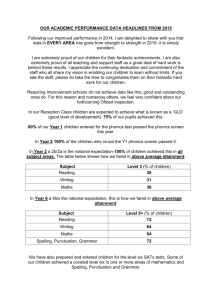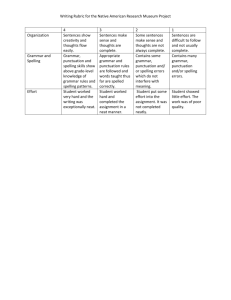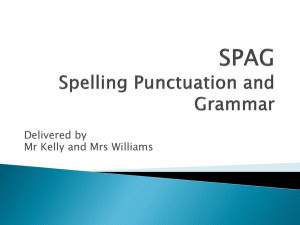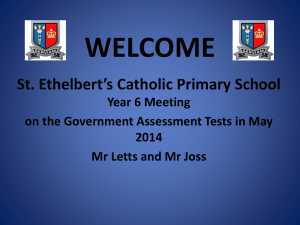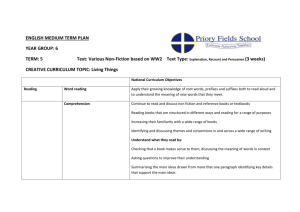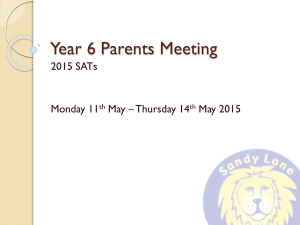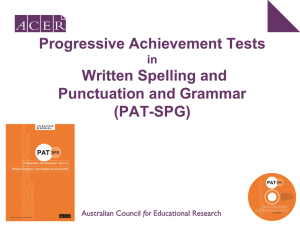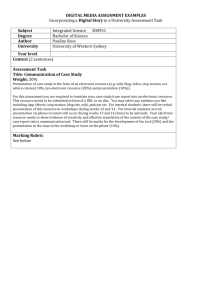Changes to National Curriculum KS1
advertisement
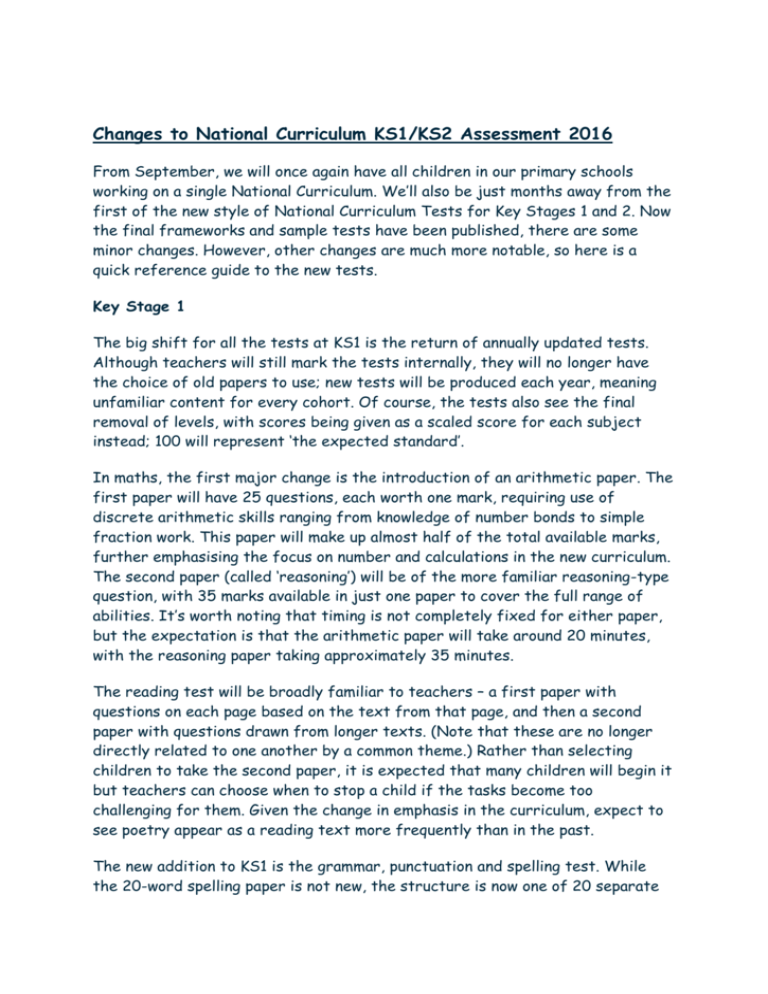
Changes to National Curriculum KS1/KS2 Assessment 2016 From September, we will once again have all children in our primary schools working on a single National Curriculum. We’ll also be just months away from the first of the new style of National Curriculum Tests for Key Stages 1 and 2. Now the final frameworks and sample tests have been published, there are some minor changes. However, other changes are much more notable, so here is a quick reference guide to the new tests. Key Stage 1 The big shift for all the tests at KS1 is the return of annually updated tests. Although teachers will still mark the tests internally, they will no longer have the choice of old papers to use; new tests will be produced each year, meaning unfamiliar content for every cohort. Of course, the tests also see the final removal of levels, with scores being given as a scaled score for each subject instead; 100 will represent ‘the expected standard’. In maths, the first major change is the introduction of an arithmetic paper. The first paper will have 25 questions, each worth one mark, requiring use of discrete arithmetic skills ranging from knowledge of number bonds to simple fraction work. This paper will make up almost half of the total available marks, further emphasising the focus on number and calculations in the new curriculum. The second paper (called ‘reasoning’) will be of the more familiar reasoning-type question, with 35 marks available in just one paper to cover the full range of abilities. It’s worth noting that timing is not completely fixed for either paper, but the expectation is that the arithmetic paper will take around 20 minutes, with the reasoning paper taking approximately 35 minutes. The reading test will be broadly familiar to teachers – a first paper with questions on each page based on the text from that page, and then a second paper with questions drawn from longer texts. (Note that these are no longer directly related to one another by a common theme.) Rather than selecting children to take the second paper, it is expected that many children will begin it but teachers can choose when to stop a child if the tasks become too challenging for them. Given the change in emphasis in the curriculum, expect to see poetry appear as a reading text more frequently than in the past. The new addition to KS1 is the grammar, punctuation and spelling test. While the 20-word spelling paper is not new, the structure is now one of 20 separate sentences; the words are likely to be more challenging, in line with the expectations of the new curriculum (the sample paper includes ‘rainbow’ and ‘peaceful’). The grammar and punctuation paper is a wholly new venture. Worth 20 marks, most of the questions are short-answer or tick-box types, but there is a clear increase in the expectations relating to grammar, including changing the tense of verbs and identifying word classes in various contexts. Implications for KS1 teachers Arithmetic is rewarded with a significant proportion of the marks available in the maths test, so plenty of practice of number facts, including the 2×, 5× and 10× tables, will be worthwhile. Almost all children will be expected at least to start both reading papers; this may have practical implications for the organisation of the test as much as anything else. Rather than an overall mark for writing, the test will only focus on the tested elements of spelling, grammar, punctuation and vocabulary, so considerable emphasis will be needed on these areas. The grammar paper sets clear expectations of knowledge of grammatical terminology. Teachers should make sure that both they and their pupils are familiar with the terms used in the grammar appendix (Appendix 2) of the new National Curriculum for English. Teachers may want to use the words-in-sentence type dictation questions for spelling tests in KS1 so that these are familiar to children when they sit the test. Spelling will account for half the marks awarded in the grammar, punctuation and spelling test, with approximately one-third awarded for aspects of grammar. Watch out for the definition of an exclamation: the test will only credit answers that begin with either “How …” or “What …” (e.g. “How exciting!”). Key Stage 2 National Curriculum Tests at Key Stage 2 seem to have changed repeatedly in the last few years, so the changes in 2016 will perhaps be not so much a shock as a feeling of ongoing change. Nevertheless, there are some significant areas that are worthy of teachers’ attention in KS2. Of course, the tests also see the final removal of levels, with scores being given as a scaled score for each subject instead; 100 will represent ‘the expected standard’. In maths, the major change is the introduction of an arithmetic paper in lieu of the old mental mathematics test. The arithmetic paper will have 35–40 questions, most of which will be worth one mark, requiring use of discrete arithmetic skills ranging from basic addition and subtraction to calculations with fractions. The questions are all in the form of calculations – there are no words. At 40 marks, this paper will make up just over one-third of the total available marks, further emphasising the focus on number and calculations in the new curriculum. Importantly, for multiplication and division questions involving larger numbers, two marks are available. However, only the standard methods of long multiplication and division will be worthy of any credit if the final answer is incorrect; other methods will be ignored. Time is critical in this paper, with 30 minutes to answer the questions; less than one minute per mark. The second and third papers will be of the more familiar reasoning-type question, with 35 marks available in each test paper to cover the full range of abilities. The sample materials clearly demonstrate a rise in expectations, with even the earliest questions offering some challenge to pupils who might previously have been thought of as working at the “borderline” of level 4. Calculators cannot be used with any of the papers. The reading test will be broadly familiar to experienced teachers. As recently, pupils will have an hour to read several texts on different themes and topics, and respond to the given questions in a separate booklet. The vast majority of marks are given over to information retrieval and inference/deduction questions, with just a handful available for elements of authorial craft. Tests will also require at least one question – and occasionally several – involving summarising text from more than one paragraph. There will be a handful of three-mark questions too, usually requiring supporting evidence drawn from the text – a skill that wasn’t much drawn upon in the old-style tests. The new grammar, punctuation and spelling test reflects the significant shifts in expectation in the new National Curriculum. The structure of both papers is broadly similar to the 2015 materials, with a 20-word spelling test and a separate test of grammar, punctuation and vocabulary. Expect to see a much more challenging set of words in the spelling test – the sample test examples range from ‘discover’ to ‘drawer’ and ‘possessions’ (words that frequently appear on lists that trip up adults!). Similarly, the demands of the new curriculum are evident in the grammar, punctuation and vocabulary paper, including lesscommon prefixes, knowledge of terminology of all the main word classes, and being able to differentiate between different types of conjunction, or words used as conjunctions and prepositions. Implications for KS2 teachers Arithmetic is rewarded with a significant proportion of the marks available in the maths papers, so plenty of practice of standard written methods and arithmetic at a pace will be worthwhile. Elements of authorial craft, such as purposeful word choice, are tested, so focusing on these specific elements when reading class texts is important. Regular teaching of spelling patterns from the appendices of the new National Curriculum will be essential if children are to make the most of the 20 marks available on the spelling test. The grammar paper sets clear expectations of knowledge of grammatical terminology. Teachers should make sure that both they and their pupils are familiar with the terms used in the grammar appendices of the new National Curriculum for English. Teachers would do well to take a close look at the mark scheme provided with the sample materials. The commentary for each question offers useful guidance on what would and would not be accepted as an answer – including some surprisingly specific rules about, for example, the use of colons with lists and the structure of questions.
